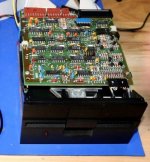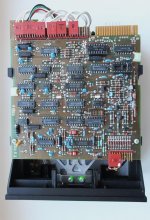voidstar78
Veteran Member
So, when I entered the PC world, I was spoiled and had DD 360KB drives available.
I never had to flip disks. But I've seen it done. Except not sure if that was on a IBM (maybe it was on a TRS-80 system).
When PC-DOS 1.0 came out - it was on a 160KB formatted single sided disk, correct? Was disk flipping ever a thing on the IBM PC? Cause I read there was a 320KB format - so 160KB is a single sided, and 320KB was double-sided? [ you could load BASICA, flip the disk, and save BASIC programs on the other side of the boot disk? ]
But then there was 180KB and 360KB. Was this using the same drives in the original (model A) 5150, but needed a BIOS update to support? [ and in the early days, it wasn't a big deal to order or obtain a BIOS update chip from a computer store or IBM mail-order themselves? ]
Like I was looking at Microsoft Adventure, and its little document says it is a "non-dos" 180KB disk (of which WinImage won't read).
The HxC device I got - that emulates disks - it'll support those 180KB images, but not the 160KB images. So the earliest PC-DOS I was able to boot (in the 5150 model B) was PC-DOS 2.10 (which I understand now they added 360KB {or 180KB single-sided} support in v2, so that makes sense).
Now I've read that there is some hex codes that have to get added to the 160KB images - is that to make them work with newer BIOS or newer disk controllers? (or both?) So at some point, when you upgraded the BIOS of a 5150 model A -- it would no longer read those earlier 160KB formatted disks?
Just kind of confused, since I'm having trouble running Serenia and Adventure on my 5150 (model B).
I never had to flip disks. But I've seen it done. Except not sure if that was on a IBM (maybe it was on a TRS-80 system).
When PC-DOS 1.0 came out - it was on a 160KB formatted single sided disk, correct? Was disk flipping ever a thing on the IBM PC? Cause I read there was a 320KB format - so 160KB is a single sided, and 320KB was double-sided? [ you could load BASICA, flip the disk, and save BASIC programs on the other side of the boot disk? ]
But then there was 180KB and 360KB. Was this using the same drives in the original (model A) 5150, but needed a BIOS update to support? [ and in the early days, it wasn't a big deal to order or obtain a BIOS update chip from a computer store or IBM mail-order themselves? ]
Like I was looking at Microsoft Adventure, and its little document says it is a "non-dos" 180KB disk (of which WinImage won't read).
The HxC device I got - that emulates disks - it'll support those 180KB images, but not the 160KB images. So the earliest PC-DOS I was able to boot (in the 5150 model B) was PC-DOS 2.10 (which I understand now they added 360KB {or 180KB single-sided} support in v2, so that makes sense).
Now I've read that there is some hex codes that have to get added to the 160KB images - is that to make them work with newer BIOS or newer disk controllers? (or both?) So at some point, when you upgraded the BIOS of a 5150 model A -- it would no longer read those earlier 160KB formatted disks?
Just kind of confused, since I'm having trouble running Serenia and Adventure on my 5150 (model B).


